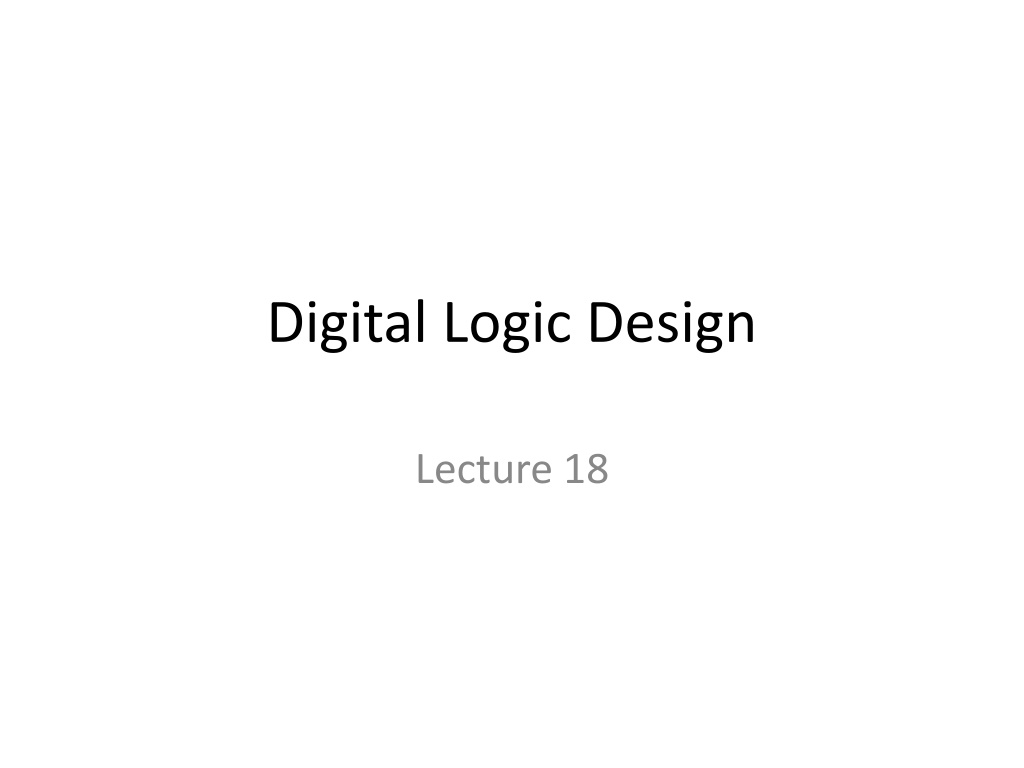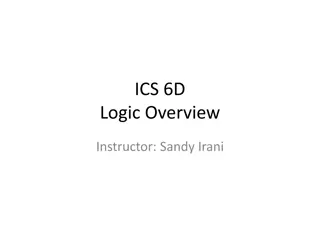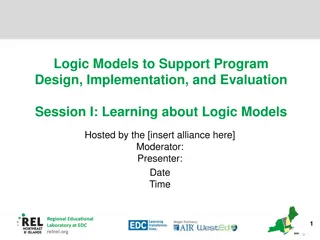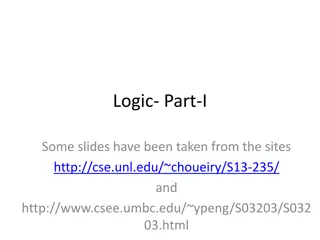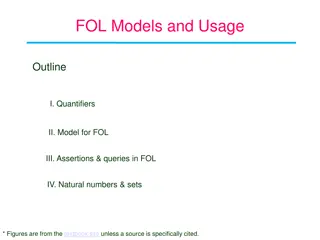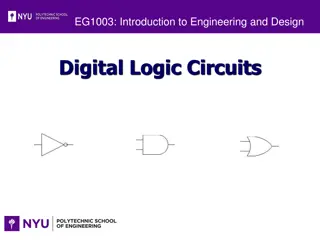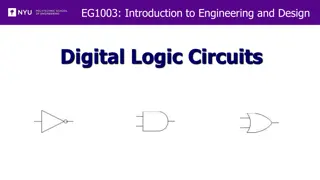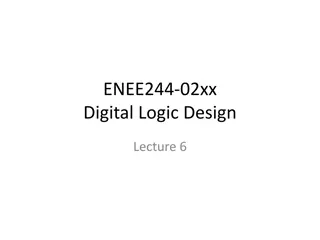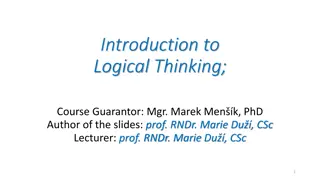Understanding Digital Logic Design Fundamentals
Delve into the intricate world of digital logic design with a focus on components like binary adders, subtracters, and comparators. Explore the concept of scale of integration and learn about MSI components and the realization of full binary adders. Discover how to simplify circuits and grapple with the challenge of adding binary numbers with multiple bits.
Download Presentation

Please find below an Image/Link to download the presentation.
The content on the website is provided AS IS for your information and personal use only. It may not be sold, licensed, or shared on other websites without obtaining consent from the author. Download presentation by click this link. If you encounter any issues during the download, it is possible that the publisher has removed the file from their server.
E N D
Presentation Transcript
Digital Logic Design Lecture 18
Announcements HW 6 up on webpage, due on Thursday, 11/6
Agenda MSI Components Binary Adders and Subtracters (5.1, 5.1.1) Carry Lookahead Adders (5.1.2, 5.1.3) Decimal Adders (5.2) Comparators (5.3)
Scale of Integration Scale of Integration = Complexity of the Chip SSI: small-scale integrated circuits, 1-10 gates MSI: medium-scale IC, 10-100 gates LSI: large scale IC, 100-1000 gates VLSI: very large-scale IC, 1000+ gates Today s chip has millions of gates on it. MSI components: adder, subtracter, comparator, decoder, encoder, multiplexer.
Scale of Integration LSI technology introduced highly generalized circuit structures known as programmable logic devices (PLDs). Can consist of an array of and-gates and an array of or- gates. Must be modified for a specific application. Modification involves specifying the connections using a hardware procedure. Procedure is known as programming. Three types of programmable logic devices: Programmable read-only memory (PROM) Programmable logic array (PLA) Programmable array logic (PAL)
Binary Full Adder ?? 0 ?? 0 ?? 0 ??+? 0 ?? 0 0 0 1 0 1 0 1 0 0 1 0 1 1 1 0 1 0 0 0 1 1 0 1 1 0 1 1 0 1 0 1 1 1 1 1
Finding a Simplified Circuit 0 1 0 1 0 0 1 0 1 0 1 0 0 1 1 1 Corresponding minimal sums: ??= ??????+ ??????+ ??????+ ?????? ??+1= ????+ ????+ ???? We can simplify the sum for ?? by using xor: ??= ?? ?? ??
Realization of Full Binary Adder ?? ?? ?? ?? ??+1
What about many bits? Consider addition of two binary numbers, each consisting of ? bits. Direct approach: Write a truth table with 22? rows corresponding to all the combinations of values and specifying the values of the sum bits. Then find a minimal combinational network. This will be intractable.
Parallel (ripple) Binary Adder ?3 ?3 ?2 ?2 ?1 ?1 ?0 ?0 ??? ?3 ?2 ?1 ? ? ? ? ??? ??? ??? ??? ? ? ? ? ???? ? ???? ? ???? ? ???? ? ?3 ?2 ?1 ???? ?3 ?2 ?1 ?0 Why is it called ripple adder? Recall signed binary numbers, final carry-out may signal overflow.
Binary Subtracters Compute: ?? ??. ?? is a borrow-in bit from previous bit-order position. ??+1 is a borrow-out bit. ?? 0 ?? 0 ?? 0 ??+? 0 ?? 0 0 0 1 0 1 0 0 1 1 1 0 0 1 0 1 1 1 0 1 1 1
Binary Subtracters Compute: ?? ??. ?? is a borrow-in bit from previous bit-order position. ??+1 is a borrow-out bit. ?? 0 ?? 0 ?? 0 ??+? 0 ?? 0 0 0 1 1 1 1 0 1 0 10 -0 0 1 1 1 0 0 1 0 1 1 1 0 1 1 1
Binary Subtracters Compute: ?? ??. ?? is a borrow-in bit from previous bit-order position. ??+1 is a borrow-out bit. ?? 0 ?? 0 ?? 0 ??+? 0 ?? 0 0 0 1 1 1 0 1 0 1 1 10 -1 0 1 1 1 0 0 1 0 1 1 1 0 1 1 1
Binary Subtracters Compute: ?? ??. ?? is a borrow-in bit from previous bit-order position. ??+1 is a borrow-out bit. ?? 0 ?? 0 ?? 0 ??+? 0 ?? 0 0 0 1 1 1 1 0 1 0 1 1 10 -1 0 1 1 1 0 1 0 0 1 0 1 1 1 0 1 1 1
Binary Subtracters Compute: ?? ??. ?? is a borrow-in bit from previous bit-order position. ??+1 is a borrow-out bit. ?? 0 ?? 0 ?? 0 ??+? 0 ?? 0 0 0 1 1 1 1 0 1 0 1 1 0 1 1 1 0 1 0 0 0 1 1 0 1 0 0 1 1 0 0 0 1 1 1 1 1
Finding a Simplified Circuit ?? = ?? ?? ?? (Same as sum in adder) ??+1= ????+ ????+ ???? ?2 ?2 ?1 ?1 ?0 ?0 ?3 ?3 ?0 ?4 ?2 ?1 ?0 ?3
A better approach using 2s complement ?2 ?1 ?0 ?3 ?3 ?2 ?1 ?0 ???= 1 ?3 ?2 ?1 ? ? ? ? ??? ??? ??? ??? ? ? ? ? ???? ? ???? ? ???? ? ?3 ?2 ?1 ???? ?3 ?2 ?1 ?0
Parallel Adder/Subtracter ?3 ?2 ?1 ?0 ?2 ?0 ?3 ?1
Carry Lookahead Adder Ripple effect: If a carry is generated in the least-significant-bit the carry must propagate through all the remaining stages. Assuming two-levels of logic are need to propogate the carry through each of the next higher-order stages. Delay is 2n. Must speed up propagation of the carries. Adders designed with this consideration in mind are called high-speed adders.
Carry Lookahead Adder Consider ??+1= ????+ ????+ ???? = ???? + ??+ ???? The first term ???? is called the carry-generate function since it corresponds to the formation of a carry at the i-th stage. The second term ??+ ???? corresponds to a previously generated carry ?? that must propagate past the i-th stage to the next stage. The ??+ ?? part of this term is called the carry- propagate function. Carry-generate function will be denoted by ??, carry-propagate function will be denoted by ??.
Carry Lookahead Adder ??= ???? ??= ??+ ?? ??+1= ??+ ???? Using this general result, the output carry at each of the stages can be written in terms of the ? s, ? s and initial input carry ?0.
Carry Lookahead Adder ?1= ?0+ ?0?0 ?2= ?1+ ?1?1 = ?1+ ?1?0+ ?0?0 = ?1+ ?1?0+ ?1?0?0 ?3= ?2+ ?2?2 = ?2+ ?2(?1+ ?1?0+ ?1?0?0) = ?2+ ?2?1+ ?2?1?0+ ?2?1?0?0 ??+1 = ??+ ???? 1+ ???? 1?? 2+ + ???? 1 ?1?0 + ???? 1 ?0?0 Why is this a good idea? Do we save on computation?
Carry Lookahead Adder What is the delay? One level of logic to form g s, p s Two levels of logic to propagate through the carry lookahead One level of logic to have the carry effect a sum output. Total: 4 units of time.
Large High-Speed Adders The carry lookahead network can very large as the number of bits increases. Approach: Divide bits of the operands into blocks, use carry lookahead adders for each block. Cascade the adders for the blocks. Ripple carries occur between the cascaded adders.
Another Approach to Large High- Speed Adders Carry lookahead generators that generate the carry of an entire block. Assume 4-bit blocks. For each block, 4-bit carry lookahead generator outputs: ? = ?3+ ?3?2+ ?3?2?1+ ?3?2?1?0 ? = ?3?2?1?0
Decimal Adders 8421 weighted coding scheme or BCD Code Decimal Digit BCD 0 0000 1 0001 2 0010 Forbidden codes: 1010, 1011, 1100, 1101, 1110, 1111 3 0011 4 0100 5 0101 6 0110 7 0111 8 1000 9 1001
Decimal Adder Inputs: ?3?2?1?0, ?3?2?1?0,??? from previous decade. Output: ???? (carry to next decade), ?3?2?1?0. Idea: Perform regular binary addition and then apply a corrective procedure.
